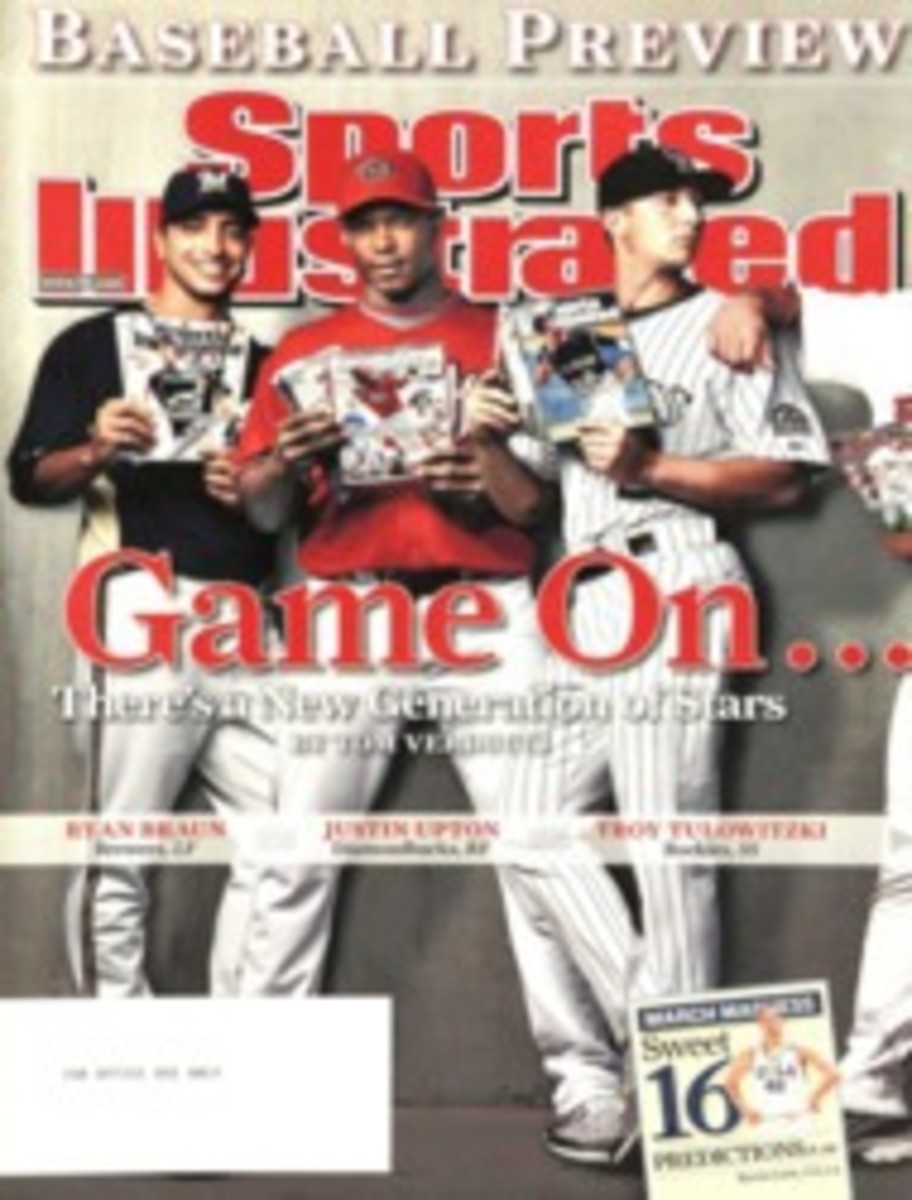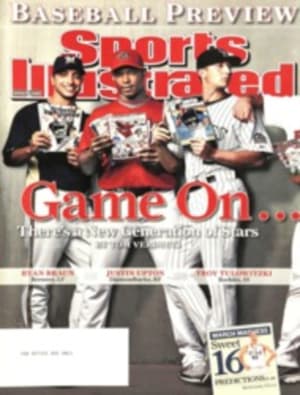
Pom-poms and Circumstance
CINDERELLAS COME and go, sock heights rise and fall, but the March Madness tableau stays remarkably constant. Survivors exalt, upset victims cry, Billy Packer rants and cheerleaders pump their pom-poms, seemingly oblivious to the score, the clock, the schoolmate writhing in pain on the vivid center court logo. CBS's cameras tend to linger on the cheerleaders every time the action pauses. You've never seen people so happy to be heading to a commercial.
It's no mystery why the mostly male sports audience doesn't mind endless shots of sexy, enthusiastic women bouncing on a hardwood floor. But fascination with cheerleaders goes beyond the superficial. Life in so many ways is just an extension of high school, and cheerleaders, like jocks or geeks, are stock characters you can relate to long after graduation. Hold that thought: What I learned during the year I spent following three college squads for my book, CHEER! is that the stereotypes are at odds with the realities of modern cheerleading. Here are five truths—not all pleasant—about this not-so-innocent breed.
1. Cheerleaders don't all wear skirts. On the college level, 50% of cheerleaders are guys, and most of the men are serious athletes, quite capable of excelling at other sports. Take James Brown, who cheers for Stephen F. Austin University. Brown played football his freshman year of college but quit out of frustration with a new coach. "My friend Tiffany talked me into going to a cheer practice," says Brown. "I didn't have anything else to do, and I needed to stay in shape."
Like James, male cheerleaders are often initially drawn to the sport by a girlfriend, or some cute woman who approached them in the weight room and invited him to practice. Which brings us to another false stereotype—that male cheerleaders must be gay. Sure, there's the occasional male cheerleader who is out of the closet, but as Steven Medley, also of Stephen F. Austin, explained, those are the exception, not the rule. "My first practice, I was just like, 'Wow. Look at all the girls,'" said Medley. "There's no other sport where you get to be around women all the time."
2. No spring break. Cheerleading season never ends, and every week the average college cheerleader spends 20 hours practicing, plus about three afternoons or evenings cheering at games. Since part of their job is to look good in their uniform, cheerleaders also work out on their own, doing sit-ups by the thousands and push-ups by the hundreds. It's more than dedication that drives cheerleaders to work like this—for some it's a compulsion. Japaul Winston, 20, who cheered for Southern University last year, says, "Cheerleading is like a drug. It's addictive. You see some new stunt or tumbling pass, and you have to work until you can do it."
3. Cutthroat competitions. Since the 1980s cheerleading has been a competitive sport, with teams eyeing one all- important competition each year—nationals. Months of training go into a routine that lasts two minutes and 15 seconds, and if they screw up, there's no chance for redemption. The top places are often decided by hundredths of a point. And just as Duke has its North Carolina and Ohio State its Michigan, top cheer teams cultivate serious rivalries. Powerhouse programs like Stephen F. Austin and Wichita State, and Kentucky and Central Florida battle every year at nationals.
4. A broken finger (or spine)—no problem. Two years ago Southern Illinois cheerleader Kristi Yamaoka made national news when she fell off a human pyramid during a basketball game and was carried out of the arena on a stretcher—still cheering. Over the past 23 years 107 female athletes died or were paralyzed in a high school or college sport; 60 were cheerleaders. In 2006 close to 25,000 cheerleaders landed in the emergency room. (On Sunday, Georgia cheerleader Christine Conley was carried off on a stabilizing board after hitting the back of her head during an NCAA women's tournament game in Norfolk. She was to be released from the hospital on Monday.) Cheerleaders put their bodies in extreme situations, and for many the adrenaline rush that comes with physical risk is the chief allure of the sport. Ask a college cheerleader about injuries, and she or he will usually have a list. "I've gotten four concussions, broken a rib, knocked my jaw out of place and broken fingers," said Shannon Six, a cheerleader at the University of Oklahoma from 2001 to '05. Cheerleaders talk about injuries the way soldiers recount battle wounds—as symbols of their hard work and resilience.
5. Bodies to the limit. The aesthetic on coed cheerleading teams is tiny women with burly men to toss them around. Some teams publish weight limits—women over, say, 115 pounds need not apply—and female cheerleaders feel a lot of pressure to stay slim. In my book one woman candidly discusses her bulimia. Another talks about abusing cocaine to lose weight.
A different type of drug culture is emerging too. On Good Morning America last month a female high school cheerleader described using the steroid Winstrol. Men in the sport feel the pressure too—it's considered embarrassing for a guy cheerleader to weigh less than a cut 200 pounds, so the image of the doughy Will Ferrell cheerleader aside, gaining and maintaining muscle mass becomes important. While NCAA sports have regimented drug testing and a list of banned substances, cheerleading is considered an "activity" and doesn't operate under the NCAA umbrella. Individual schools decide whether to test cheerleaders, and many don't. Over the past year I met several male cheerleaders who said they used steroids too. One is now a cheerleading coach at a top-ranked school. It is another sign that for better and worse, cheerleading has become as real as any sport out there. Something to think about the next time CBS cuts to a commercial.
Kate Torgovnick is the author of CHEER!: Three Teams on a Quest for College Cheerleading's Ultimate Prize.
ONLY AT SI.COM
Your one stop for offbeat humor and the wackiest sports stories and links, including Hot Clicks and the Daily List, is SI.com/extramustard.
"For many cheerleaders, the allure of the sport is the RUSH THAT COMES WITH PHYSICAL RISK."
PHOTO ILLUSTRATION
PHOTO ILLUSTRATION BY JOHN UELAND

